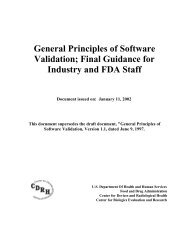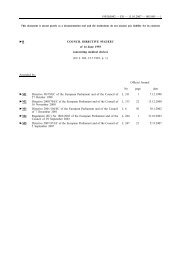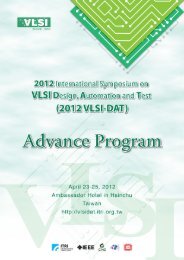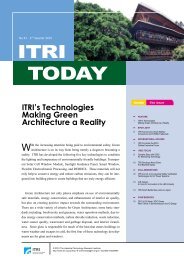Design Control Guidance - Food and Drug Administration
Design Control Guidance - Food and Drug Administration
Design Control Guidance - Food and Drug Administration
You also want an ePaper? Increase the reach of your titles
YUMPU automatically turns print PDFs into web optimized ePapers that Google loves.
PREFACEEffective implementation of design controls requires that the regulation <strong>and</strong> its intent be wellunderstood. The Office of Compliance within CDRH is using several methods to assistmanufacturers in developing this underst<strong>and</strong>ing. Methods include the use of presentations,teleconferences, practice audits, <strong>and</strong> written guidance.Those persons in medical device companies charged with responsibility for developing,implementing, or applying design controls come from a wide variety of technical <strong>and</strong> non-technicalbackgrounds––engineering, business administration, life sciences, computer science, <strong>and</strong> the arts.Therefore, it is important that a tool be provided that conveys the intent of the regulation usingpractical terminology <strong>and</strong> examples. That is the purpose of his guidance.The response of medical device manufacturers <strong>and</strong> other interested parties to the March, 1996 draftversion of this guidance has significantly influenced this latest version. Most comments centeredon the complaint that the guidance was too prescriptive. Therefore, it has been rewritten to bemore pragmatic, focusing on principles rather than specific practices.It is noteworthy that many comments offered suggestions for improving the guidance, <strong>and</strong> that theauthors of the comments often acknowledged the value of design controls <strong>and</strong> the potential benefitof good guidance to the medical device industry, the public, <strong>and</strong> the FDA. Some comments evenincluded examples of past experiences with the implementation of controls.Finally, there are several people within CDRH that deserve recognition for their contributions tothe development of this guidance. Al Taylor <strong>and</strong> Bill Midgette of the Office of Science <strong>and</strong>Technology led the development effort <strong>and</strong> served as co-chairs of the CDRH <strong>Design</strong> <strong>Control</strong><strong>Guidance</strong> Team that reviewed the comments received last spring. Team members included AshleyBoulware, Bob Cangelosi, Andrew Lowrey, Deborah Lumbardo, Jack McCracken, GregO'Connell, <strong>and</strong> Walter Scott. As the lead person within CDRH with responsibility forimplementing the Quality System Regulation, Kim Trautman reviewed the guidance <strong>and</strong>coordinated its development with the many other concurrent <strong>and</strong> related activities. Theircontributions are gratefully acknowledged.FDA would also like to acknowledge the significant contributions made by the GlobalHarmonization Task Force (GHTF) Study Group 3. The Study Group reviewed <strong>and</strong> revised thisguidance at multiple stages during its development. It is hoped that this cooperative effort will leadto this guidance being accepted as an internationally recognized guidance document through theGHTF later this year.Lillian J. GillDirectorOffice of Complianceiii
















